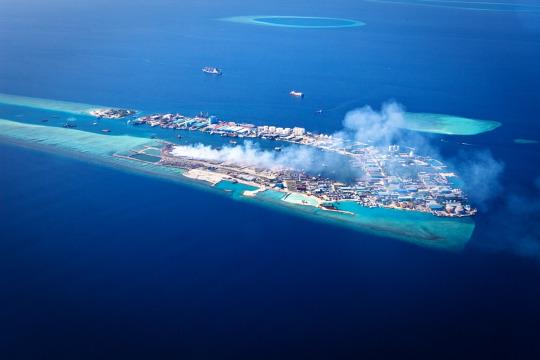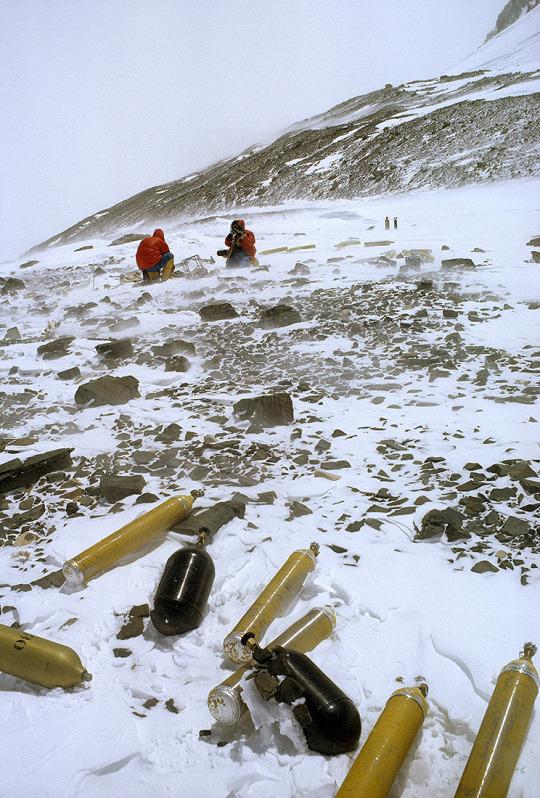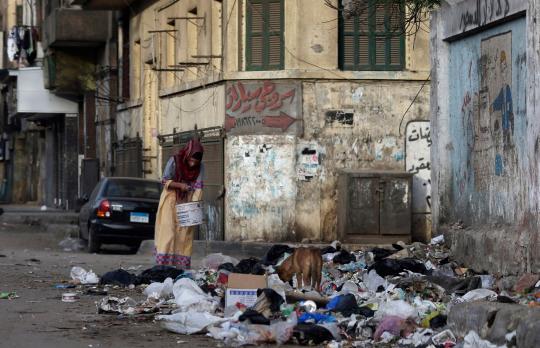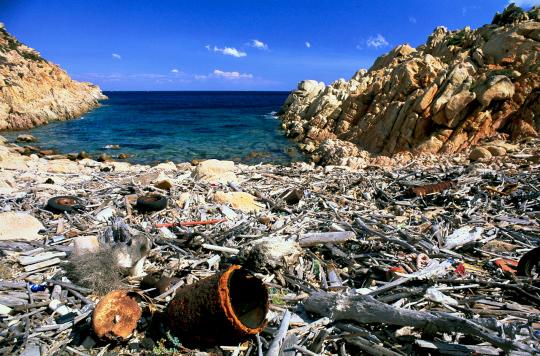Last week we did a very unsettling show on the trash problem in Nigeria. This does not alleviate any of our concern or consternation.
Managing trash and energy are the two biggest components, the challenges that will make or break our sustainability goals, we face today. Plastic chokes our oceans, bottles and cans drowned Haiti after the earthquake, landfill are full and cities are littered with garbage. Finally, as we see here, some of our most pristine sites are decayed and destroyed by waste.
From this point forward, every company that delivers food products, electronics, any consumer goods should be required to provide the buyer with an easy means of recycling the packaging. We need accountability. We need packaging to be biodegradable. We need to change...fast.
Beautiful Vacation Destinations Overtaken By Trash
by Sophie Forbes
Our planet is inhabited by more than seven billion people and grows by nearly 100,000 people a day. The World Bank estimates that three billion of our population lives in urban areas, and produces more than 1.3 billion tons of solid waste a year.
By 2025, the amount of waste we produce as a planet is set to exceed 2.2 billion metric tons a year, and by 2100 we will be churning out more than 11 million tons a day.
As a result many of our world’s most beautiful and historic destinations are being buried under mountains of trash that just can’t be disposed of at a fast enough rate. Here are some of the worst:
By 2025, the amount of waste we produce as a planet is set to exceed 2.2 billion metric tons a year, and by 2100 we will be churning out more than 11 million tons a day.
As a result many of our world’s most beautiful and historic destinations are being buried under mountains of trash that just can’t be disposed of at a fast enough rate. Here are some of the worst:
Maldives

Trash litters the beach in Maldives. (Photo: Michele Westmorland/Corbis)
Tourism is a major cause of increased trash production for many countries, and island communities are particularly at risk due to their isolation and space issues. Every year, more than 750,000 head to the paradise-like resorts of the Maldives islands, but this massive influx of people has created an uncontrollable flow of trash buildup that the country’s government is now struggling to deal with.
Things got so bad, that in 1992 the country allocated one of the islands, Thilafushi, to be turned into a makeshift dumping ground for all of the nation’s waste — and it has been nicknamed “The Rubbish Island.” What was once a picturesque lagoon with white sand, coral reefs and crystal-clear waters was turned into a toxic dump where hundreds of tons of rubbish were dumped and burned on a daily basis, creating a reclaimed island spanning more than 124 acres.

Smoke billowing as trash is burned off on Thilafushi Island, which has been dedicated to waste disposal. (Photo: Ibrahim Muneez/National Geographic Creative/Corbis)
Broken oil drums, lead, asbestos and other metals, along with an abundance of plastics and food waste created a major biohazard as well as disgustingly increased fly and bug activity. Smoke also polluted the air around the island from all the burning waste. Gross.
This practice of using the island as a dumping ground began being phased out in 2011 after several ships bringing piles of waste to the island began dumping it straight into the ocean. All waste is now shipped to India, where it is sorted and sold. But it will be years, if not decades, before the islands local habitat will be returned to is former natural beauty. If that is even possible.
Mount Everest

Trash and abandoned supplies left behind by climbers on Mount Everest. (Photo: Barry C. Bishop/National Geographic/Getty Images)
Every year, more than 300 climbers attempt the daring and dangerous feat of scaling Mount Everest. These mountaineers are usually joined by just as many sherpas who are responsible for guiding the expeditions up the peaks.
Over the years, these groups of explorers have left behind huge amounts of trash on the mountain — everything from tents, equipment and clothing to plastic bottles, tins and food packets. There is also an insane amount of human feces that have accumulated in the base camps and camping sites on the climbing routes. Because of the amount of buildup, Mount Everest is now being referred to as the World’s Highest Junkyard.
The situation has become such that the levels of toxic waste are now threatening the ecosystem and could potentially spread disease down through mountain streams to local communities living at the foot of the range. Napal has now introduced very strict penalties on groups littering the natural wonder and religious site, introducing a rule that requires a $4,000 deposit which is forfeited should a climber fail to bring back an 8-kilogram bag of trash and human waste to the base camp.
The Indian Army is also planning several clean up operations this climbing season, which runs from March to May.
Mexico City
The situation has become such that the levels of toxic waste are now threatening the ecosystem and could potentially spread disease down through mountain streams to local communities living at the foot of the range. Napal has now introduced very strict penalties on groups littering the natural wonder and religious site, introducing a rule that requires a $4,000 deposit which is forfeited should a climber fail to bring back an 8-kilogram bag of trash and human waste to the base camp.
The Indian Army is also planning several clean up operations this climbing season, which runs from March to May.
Mexico City

Rubbish is piled up next to the monument of Mexico’s late President Benito Juarez in Mexico City. (Photo: REUTERS/Bernardo Montoya)
Mexico City is the country’s largest city as well as its political, financial and cultural center. Originally founded and built in 1325, it is considered the oldest capital city in all the Americas, rich in history and deep cultural qualities dating to the Aztecs. The city has a population of more than 21 million people, making it the largest metropolitan area in the Western Hemisphere.
In the past few decades, the city has developed one of the world’s worst garbage problems. For years, the majority of the city’s waste was taken to the Bordo Poniente landfill. One of the largest on the planet, this site took more than 14,000 tons of trash per day and took up more than 927 acres of land on the outskirts of the city. After years of pollution, illegal dumping and fighting amongst politicians, the site finally closed, but this was the start of just more trash problems.

Illegally dumped garbage in the canals of Xochimilco and the Chinampas (floating gardens) located in the south of Mexico City. The uncontrolled urbanization of the area has caused severe deterioration of the canals’ water quality. (Photo: Carlos Cazalis/Corbis)
With nowhere else to take their waste, people have turned to thousands of illegal dumping sites. These have appeared all over the city, with lines of trucks stretched for miles to get into two overworked sites, and trash has began to pile up in the streets.
What was once a picturesque classical city is now drowning in a sea of its own waste. The Mexican government has been working to fix the city’s trash disposal problems by implementing recycling schemes and repurposing trash.
They are also attempting to work on the existing Bordo Poniente site, which leaks large quantities of greenhouse gasses from trash decay into the atmosphere. Officials hope to harness the gas, turning it into a form of biofuel that could power area homes and businesses.
What was once a picturesque classical city is now drowning in a sea of its own waste. The Mexican government has been working to fix the city’s trash disposal problems by implementing recycling schemes and repurposing trash.
They are also attempting to work on the existing Bordo Poniente site, which leaks large quantities of greenhouse gasses from trash decay into the atmosphere. Officials hope to harness the gas, turning it into a form of biofuel that could power area homes and businesses.
Cairo

An Egyptian woman searches through garbage on a Cairo street. (Photo: AP/Hassan Ammar)
The ancient Egyptian city of Cairo and its surrounding areas are home to one of the highest concentrations of historical landmarks seen anywhere on Earth. The Pyramids at Giza, Abu-Simbel Temples and the Temple of Luxor are just some of the attractions that have seen millions of tourists flock to the area in years past.
Of the more than 600 historical sites spread around the city, many dating to the 7th or 8th century, are now crumbling and surrounded by growing piles of garbage.
Of the more than 600 historical sites spread around the city, many dating to the 7th or 8th century, are now crumbling and surrounded by growing piles of garbage.
The problem that this city has with trash has been ongoing for years, largely to do with the inefficiency of the collection system. Cairo does not have a government-run trash collection service.

Two men who work as Zabaleen sort a garbage bag of glass by color at a recycling depot in Cairo. While unconventional, the Zabaleen system led to almost 90% of the city’s trash being recycled. (Photo: Martyn Aim/Corbis)
For the past 70 or more years, the city’s waste has been picked up a group of thousands of trash collectors known as the Zabbaleen. For a small fee, they go door to door, removing everyone’s garbage. They take it to a village on the edge of the city called Manshiyat Naser, where they pick through it in the streets looking for recyclable materials and items that can be sold off. Any leftover food items were fed to the city’s hundreds of wild pigs that roam the streets.
While unconventional, the Zabaleen’s methods meant that almost 90% of all the trash in the city got recycled. Figures that exceed the majority of other countries in the developed world.
In the past decade, the government have attempted to change the system, hiring private companies to deal with some of the trash. But in 2009, in the aftermath of the swine flu outbreak in Mexico, the authorities ordered the slaughter of all the wild pigs, leaving no way of disposing of the non-recyclables. The trash began to overflow into the streets, with rotting food piling up and a horrendous smell constantly drifting through the city.
Due to the recent political instability in the country, the trash issue has been moved further and further down the to-do list, and there doesn’t yet seem to be a solution to this devastating problem faced by Egypt.
Mediterranean Sea
While unconventional, the Zabaleen’s methods meant that almost 90% of all the trash in the city got recycled. Figures that exceed the majority of other countries in the developed world.
In the past decade, the government have attempted to change the system, hiring private companies to deal with some of the trash. But in 2009, in the aftermath of the swine flu outbreak in Mexico, the authorities ordered the slaughter of all the wild pigs, leaving no way of disposing of the non-recyclables. The trash began to overflow into the streets, with rotting food piling up and a horrendous smell constantly drifting through the city.
Due to the recent political instability in the country, the trash issue has been moved further and further down the to-do list, and there doesn’t yet seem to be a solution to this devastating problem faced by Egypt.
Mediterranean Sea

Plastic and garbage floating in the Mediterranean Sea near Marseille’s islands. (Photo: Getty Images)
The Mediterranean Sea is a 2.5-million-kilometer-square mass of water that is almost completely enclosed by land. It also contains more than 3,300 islands and touches the coastlines of 24 countries and two continents.
It has long been considered one of the most beautiful and diverse places on Earth, rich with marine animal and plant life, and draws millions of tourists to its shores every year. But just this week a new survey found that large volumes of plastic debris are building up in the sea.
Scientists have found plastic in the stomachs of fish, birds, turtles, and whales. Tiny pieces of plastic have also been found inside oysters and mussels grown on the coasts of Northern Europe.
It has long been considered one of the most beautiful and diverse places on Earth, rich with marine animal and plant life, and draws millions of tourists to its shores every year. But just this week a new survey found that large volumes of plastic debris are building up in the sea.
Scientists have found plastic in the stomachs of fish, birds, turtles, and whales. Tiny pieces of plastic have also been found inside oysters and mussels grown on the coasts of Northern Europe.

Trash and debris on the coast of Caprera, off the coast of Sardinia, Italy. (Photo: M.L. Sinibaldi/CORBIS)
The rate of buildup has been compared to that of the ocean gyres that have accumulated due to the rotating oceanic currents of the Pacific and Atlantic oceans.
The study has scientists particularly worried about the levels of microplastics (less than 5mm in length) that have been registered in the water. Eighty percent of the plastics there fall into this category. The problem with these plastic fragments is that they get swallowed by marine wildlife, and then potentially release chemicals into their guts. This also, frighteningly, puts the plastic into the food chain to be consumed by bigger species, including humans — and the long-term effects of this are unknown.
The study has scientists particularly worried about the levels of microplastics (less than 5mm in length) that have been registered in the water. Eighty percent of the plastics there fall into this category. The problem with these plastic fragments is that they get swallowed by marine wildlife, and then potentially release chemicals into their guts. This also, frighteningly, puts the plastic into the food chain to be consumed by bigger species, including humans — and the long-term effects of this are unknown.

No comments:
Post a Comment